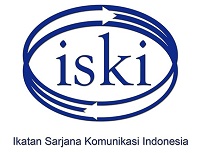Organization Communication: Internal Conflict in Hospitality Industri
Abstract
Keywords
Full Text:
PDFReferences
Bungin. Burhan. (2012). Analisis Data Penelitian Kualitatif. Jakarta: Raja Grafindo Persada.
Effendy, Onong Uchjana. (2013). Ilmu Komunikasi Teori dan Praktek. Bandung: PT Remaja Rosdakary
Dewi, Tyas Hapsari., Handayani, Agustin. (2013). Kemampuan Mengelola Konflik Interpersonal Di Tempat Kerja Ditinjau Dari Persepsi Terhadap Komunikasi Interpersonal Dan Tipe Kepribadian Ekstrovert. Jurnal Psikologi Undip Vol.12 No.1
Hardjana, Andre. (2016). Komunikasi Organisasi Strategi dan Kompentensi. Jakarta: PT. Kompas Media Nusantara.
Kaswan. (2017). Psikologi Industri dan Organisasi, Cetakan 1. Bandung: Alfabeta.
Liliweri, Alo. (2014). Sosiologi dan Komunikasi Organisasi. Jakarta: Bumi Aksara.
Marwansyah. (2010). Manajemen Sumber Daya Manusia. Bandung: Alfabeta.
Pace, R. Wayne., & Faules, Don F. (2013). Komunikasi Organisasi: Strategi Meningkatkan Kinerja Perusahaan, Terj. Deddy Mulyana. Bandung: PT Remaja Rosda Karya.
Ruben, Brent D., & Stewart, Lea P. (2013). Komunikasi dan Perilaku Manusia. Jakarta: PT Raja Grafindo Persada.
Ruslan, Rosady. (2002). Manajemen Humas danManajemen Komunikasi, Edisi Revisi. Jakarta: PT. Raja Grafindo Persada.
Santoso,Hamong. Djastuti, Indi. (2011). Partisipasi Pekerja Dalam Serikat Pekerja. Jurnal Ekonomi Pembangunan Volume 12, Nomor 2, Desember 2011, hlm.221-238 DOI: https://doi.org/10.23917/jep.v12i2.195
Sudaryono.( 2017). Metodologi Penelitian. Jakarta: PT Raja Grafindo Persada.
Sugiyono. (2016). Metode Penelitian Kuantitatif, Kualitatif dan R&D. Bandung: PT Alfabet.
Susanti, Eka Cahyani Putri., & Musadieq, Mochammad Al., & Ruhana, Ika. (2014). Pengaruh Human Relation (Hubungan Antar Manusia) dan Kondisi Lingkungan Kerja terhadap Kinerja Karyawan (Studi pada Karyawan Dinas Pekerjaan Umum Cipta Karya Kabupaten Lamongan). Jurnal Administrasi Bisnis (JAB) Vol. 17 No. 2 Tahun 2014, hal 1-9.
Suwena, I Ketut.Widyatmaja, Gst Ngurah. (2010). Pengetahuan Dasar Ilmu Pariwisata.
Denpasar: Udayana Press.
Wirawan. (2010). Konflik dan Manajemen Konflik: Teori. Aplikasi, dan Penelitian. Jakarta: Salemba Humanika.
DOI: https://doi.org/10.29313/mediator.v13i1.5636
Refbacks
- There are currently no refbacks.

This work is licensed under a Creative Commons Attribution 4.0 International License























